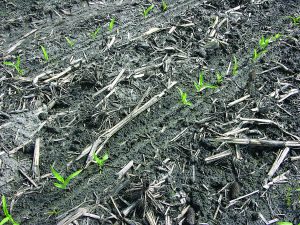With delayed planting, slower crop emergence and frequent rain events, early season pests get a longer period of time to feed on the seed and seedlings. There are a number of pests causing problems right now.

Seedcorn maggots are causing injury in both corn and soybean fields. Although higher risk fields include those that have manure or green vegetation incorporated into the soil closer to planting, these are not the only fields showing up with seedcorn maggot injury this year. Unfortunately, no rescue treatments are available for this pest so replanting is the only option to take if plant populations have been significantly impacted. The very warm temperatures (above 30oC) expected next week should help to reduce the maggot and fly activity.
Grubs and wireworms are also very active at the soil surface. Even fields with the high rate of insecticide seed treatment used may experience some injury, as each larva needs to take a bite of the seed or seedling to get a dose of the insecticide before dying. If 4 or 5 larvae bite on one seedling, the plant may not recover. Now is a good time to conduct an Inspection of Soil for those needing access to Class 12 Insecticides. These two pests will be actively feeding for a few weeks still.
Slugs thrive in a wet spring. I wish we had a good management tool for slugs besides tillage. At the very least, moving trash/crop residue away from the seed row can help, as well as ensuring that the seed slots are closed so they don’t have direct access to the seed. But moist soil surfaces help slugs crawl across bare ground. Fortunately, warmer temps next week may help speed up crop development and help the plants get past their vulnerable seedling stages.
If significant crop damage has been experienced in a field that was not planted with a Class 12 insecticide, an Inspection of Crop Pest Assessment can be done to prove need for use of Class 12 insecticide for that farm property for the next 12 months. A professional pest advisor will be required to conduct this assessment to determine if the stand loss thresholds have been met and the assessment only applies for damage incurred by grubs, wireworms, seedcorn maggots or corn rootworms for corn; or grubs, wireworms, seedcorn maggots or bean leaf beetles for soybeans. More information on an Inspection of Crop – Pest Assessment can be found here.
More information on early season field crop pests can be found at:
Guide to Early Season Field Crop Pests
Pest Manager iOS Android Blackberry
